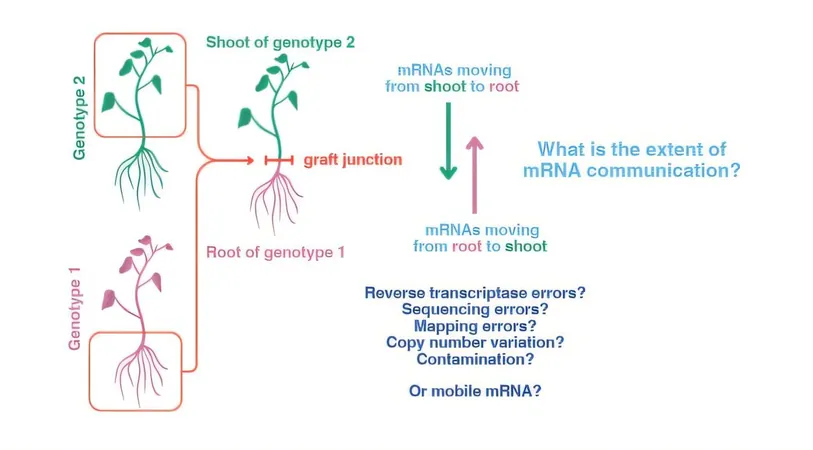
Revealing the Hidden Truth in Plant Communication: A Shocking Study
2025-04-16
Author: John Tan
Unveiling a Major Discovery in Plant Signaling
A groundbreaking study from the John Innes Centre has ignited debate within the scientific community regarding long-distance signaling networks in plants. Published in the prestigious *Nature Plants*, the findings urge a reassessment of conventional methods in the life sciences.
The Role of Mobile mRNAs in Plant Signaling
Researchers have long posited that messenger RNAs (mobile mRNAs) play a vital role in long-distance signaling among plants, likening their function to a form of 'plant internet.' These mobile mRNAs are thought to facilitate an intricate intercellular communication system that regulates various developmental and physiological processes.
Innovative Techniques in Research
To unravel these complex signaling pathways, scientists employed a grafting technique—binding one plant onto another to track the flow of mRNAs between roots and shoots. This tracking hinges on RNA sequencing (RNA seq), a powerful tool capable of detecting variations in mRNA sequences, potentially indicating the presence of mobile mRNAs.
The Noise Dilemma: A Statistical Conundrum
However, the path to understanding isn't straightforward. Researchers faced significant challenges in differentiating between genuine signaling mRNAs and background 'noise' in the RNA seq datasets. The John Innes team utilized advanced bioinformatics, genomic tools, and machine learning to develop statistical tests aimed at filtering out this interference.
Startling Findings Challenge Established Beliefs
In a startling meta-analysis, the team discovered that up to 83% of the data derived from grafted plants closely resembled background noise rather than confirming mobile mRNA signals. This revelation, described by one expert as an 'elephant in the room,' raises serious doubts about the validity of current conclusions regarding mRNA communications.
Expert Insights and Implications
Professor Richard Morris, the study's lead author, remarked, "Our analysis undermines the perceived abundance and signaling capabilities of mobile mRNAs in plants." Co-first author Dr. Melissa Tomkins added, "Our goal was to model mRNA transport, but our findings compelled us to dig deeper into our data than we initially expected."
Recommendations for Future Research
The team has outlined a series of recommendations to guide future studies, emphasizing the necessity for more robust methodologies in the exploration of long-distance mRNA transport. Dr. Pirita Paajanen, another lead author, highlighted the critical need for open data accessibility, emphasizing that such transparency amplifies the interplay of mathematics and biology.
A Call to Action in Plant Research
Professor Morris concluded, "I extend my gratitude to the exceptional team at JIC and our collaborators—their invaluable contributions were crucial in deciphering the complexities of what may be one of the most challenging datasets we've encountered." This pivotal study not only reshapes our understanding of plant communication but also sets the stage for future breakthroughs in the field.

 Brasil (PT)
Brasil (PT)
 Canada (EN)
Canada (EN)
 Chile (ES)
Chile (ES)
 Česko (CS)
Česko (CS)
 대한민국 (KO)
대한민국 (KO)
 España (ES)
España (ES)
 France (FR)
France (FR)
 Hong Kong (EN)
Hong Kong (EN)
 Italia (IT)
Italia (IT)
 日本 (JA)
日本 (JA)
 Magyarország (HU)
Magyarország (HU)
 Norge (NO)
Norge (NO)
 Polska (PL)
Polska (PL)
 Schweiz (DE)
Schweiz (DE)
 Singapore (EN)
Singapore (EN)
 Sverige (SV)
Sverige (SV)
 Suomi (FI)
Suomi (FI)
 Türkiye (TR)
Türkiye (TR)
 الإمارات العربية المتحدة (AR)
الإمارات العربية المتحدة (AR)